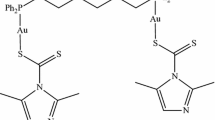Abstract
Imidazolium-trans-dimethylsulfoxideimidazoletetrachlororuthenate (NAMI-A) is a ruthenium compound effective on solid tumor metastases. In this study, we evaluated the effects of different routes of administration of NAMI-A on the distribution to primary tumor, lungs and kidneys in BD2F1 hybrids with Lewis lung carcinoma or in CBA inbred mice with MCa mammary carcinoma. NAMI-A concentration and the percentage of cumulative dose (%D tot) retained in these tissues is independent of the animal strain and of the tumor model used. Also the presence of the tumor does not change the distribution of NAMI-A in the lungs and in the kidneys. A dose-dependent antimetastatic effect is evident with intraperitoneal (i.p.) treatments at three different doses. Treatment of tumor bearing mice with NAMI-A administered i.p., per os or by aerosol showed a similar effect on lung metastases, although the concentration of ruthenium reached in the lungs was markedly different. On the basis of the data obtained, we can conclude that the antimetastatic effects are related to the amount of NAMI-A administered, rather than to the lung's concentration of the compound.
Similar content being viewed by others
References
Miyanaga N, Akaza H: Verify the optimum administration of anticancer agent-cisplatin. Gan To Kagaku Ryoho 28: 1339–1344, 2001
Jeung HC, Rha SY, Jang WI, Noh SH, Chung HC: Treatment of advanced gastric cancer by palliative gastrectomy, cytoreductive therapy and postoperative intraperitoneal chemotherapy. Br J Surg 89: 460–466, 2002
Maluf FC, Spriggs D: Anthracyclines in the treatment of gynecologic malignancies. Gynecol Oncol 85: 18–31, 2002
de Bree E, Witkamp AJ, Zoetmulder FA: Intraperitoneal chemotherapy for colorectal cancer. J Surg Oncol 79: 46–61, 2002
Kelland LR: An update on satraplatin: the first orally available platinum anticancer drug. Expert Opin Investig Drugs 9: 1373–1382, 2000
Rose WC, Lee FY, Golik J, Kadow J: Preclinical oral antitumor activity of BMS-185660, a paclitaxel derivative. Cancer Chemother Pharmacol 46: 246–250, 2000
Rose WC, Long BH, Fairchild CR, Lee FY, Kadow JF: Preclinical pharmacology of BMS-275183, an orally active taxane. Clin Cancer Res 7: 2016–2021, 2001
Koshkina NV, Waldrep JC, Roberts LE, Golunski E, Melton S, Knight V: Paclitaxel liposome aerosol treatment induces inhibition of pulmonary metastases in murine renal carcinoma model. Clin Cancer Res 7: 3258–3262, 2002
Gautam A, Densmore CL, Waldrep JC: Inhibition of experimental lung metastasis by aerosol delivery of PEI-p53 complexes. Mol Ther 2: 318–323, 2000
Sava G, Capozzi I, Clerici K, Gagliardi R, Alessio E, Mestroni G: Pharmacological control of lung metastases of solid tumours by a novel ruthenium complex. Clin Expl Metastasis 16: 371–379, 1998
Sava G, Clerici K, Capozzi I, Cocchietto M, Gagliardi R, Alessio E, Mestroni G, Perbellini A: Reduction of metastasis by ImH[trans-RuCl4(DMSO)Im]: mechanism of action investigated on mouse tumour. Anticancer Drugs 10: 129–139, 1999
Sava G, Bergamo A: Drug control of solid tumour metastases: a critical view. Anticancer Res 19: 1117–1124, 1999
Bergamo A, Zorzet S, Gava B, Sorc A, Alessio E, Iengo E, Sava G: Effects of NAMI-A and some related ruthenium complexes on cell viability after short exposure of tumor cells. Anticancer Drugs 11: 665–672, 2000
Bergamo A, Gagliardi R, Scarcia V, Furlani A, Alessio E, Mestroni G, Sava G: In vitro cell cycle arrest, in vivo action on solid metastasizing tumors, and host toxicity of the antimetastatic drug NAMI-A and cisplatin. J Pharmacol Expl Ther 289: 559–564, 1999
Vacca A, Bruno M, Boccarelli A, Coluccia M, Ribatti D, Bergamo A, Garbisa S, Sartor L, Sava G: Inhibition of endothelial cell function and of angiogenesis by the metastasis inhibitor NAMI-A. Br J Cancer 86: 993–998, 2002
Zorzet S, Bergamo A, Cocchietto M, Sorc A, Gava B, Alessio E, Iengo E, Sava G: Lack of in vitro citotoxicity, associated to increased G(2)-M cell fraction and inhibition of matrigel invasion, may predict in vivo-selective antimetastasis activity of ruthenium complexes. J Pharmacol Exp Ther 295: 927–933, 2000
Mestroni G, Alessio E, Sava G: New salts of anionic complexes of Ru(III), as antimetastatic and antineoplastic agents, PCT. C 07F 15/00, A61K 31/28. WO 98/00431 08.01.98
Zorzet S, Sorc A, Casarsa C, Cocchietto M, Sava G: Pharmacological effects of the ruthenium complex NAMI-A given orally to CBA mice with MCa mammary carcinoma. Metal Based Drugs 8: 1–7, 2001
Albini E, Arena E, Belluco G, Schioppacassi G, Ungheri D: Activity of aerosol thiamphenicol glycinate acetylcysteinate in a mouse model of S. pyogenes pneumonia. Arzneim-Forsch/Drug Res 49: 631–634, 1999
Tamura H, Arai T: Determination of ruthenium in biological tissue by graphite furnace AAS after decomposition of the sample by tetramethylammonium hydroxide. Bunseki KagaKu 41: 13–17, 1992
Cocchietto M, Sava G: Blood concentration and toxicity of the antimetastasis agent NAMI-A following repeated intravenous treatment in mice. Pharmacol Toxicol 87: 193–197, 2000
Poliak-Blazi M, Boranic M, Marzan B, Radacic MA: A transplantable aplastic mammary carcinoma of CBA mice. Vet Arh 51: 99–107, 1981
Geran RI, Geenberg NH, MacDonald MM, Schumacher AM, Abbott BJ: Protocols for screening chemical agents and natural products against animal tumors and other biological systems. Cancer Chemother Rep 3: 13, 1972
Magnarin M, Bergamo A, Carotenuto ME, Zorzet S, Sava G: Increase of tumour infiltrating lymphocytes in mice treated with antimetastatic doses of NAMI-A. Anticancer Res 20: 2939–2944, 2000
Sava G, Cocchietto M: Blood levels of ruthenium following repeated treatments with the antimetastatic compound NAMI-A in healthy beagle dogs. In Vivo 14: 741–744, 2000
Cocchietto M, Salerno G, Alessio E, Mestroni G, Sava G: Fate of the antimetastatic ruthenium complex ImH [trans-RuCl4(DMSO)Im] after acute i.v. treatment in mice. Anticancer Res 20: 197–202, 2000
Sava G, Bergamo A, Zorzet S, Gava B, Casarsa C, Cocchietto M, Furlani A, Scarcia V, Serli B, Iengo E, Alessio E, Mestroni G: Influence of chemical stability on the activity of the antimetastasis ruthenium compound NAMI-A. Eur J Cancer 38: 427–435, 2002
Author information
Authors and Affiliations
Rights and permissions
About this article
Cite this article
Cocchietto, M., Zorzet, S., Sorc, A. et al. Primary Tumor, Lung and Kidney Retention and Antimetastasis Effect of NAMI-A Following Different Routes of Administration. Invest New Drugs 21, 55–62 (2003). https://doi.org/10.1023/A:1022916310694
Issue Date:
DOI: https://doi.org/10.1023/A:1022916310694



